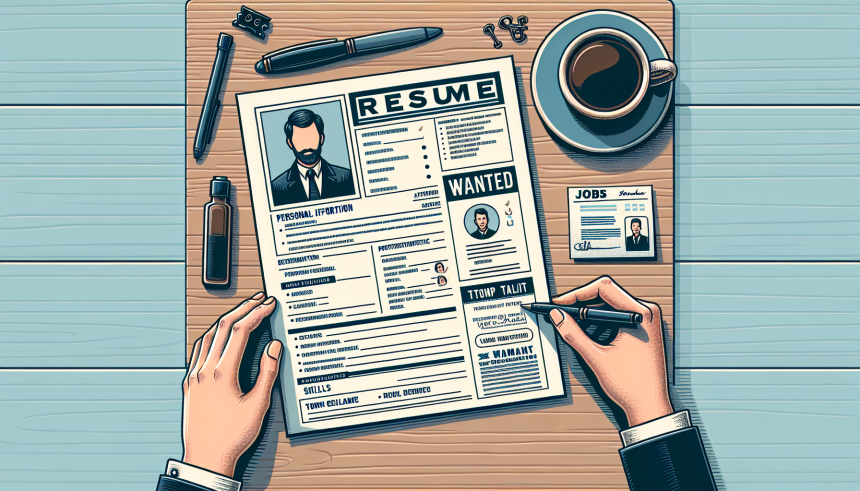Understanding the Basics of a Resume
A resume is a critical marketing tool showcasing your skills, experience, and qualifications to potential employers. An effective resume can make the difference between landing an interview and getting lost in the avalanche of applications.
Step 1: Choose the Right Format
Selecting the right resume format is essential. There are three main types:
-
Chronological: Lists work experience in reverse chronological order, which is ideal for those with a solid work history in a specific field.
-
Functional: Focuses on skills and experiences rather than chronological work history, perfect for career changers or those with gaps in their employment.
-
Combination: Blends both chronological and functional elements, suitable for applicants with diverse skill sets and experiences.
Step 2: Personal Information
At the top of your resume, include your name, phone number, email address, and LinkedIn profile (if applicable). This section should be clear and easy to read. Ensure that your email address is professional, ideally a combination of your first and last name.
Step 3: Craft a Compelling Summary
Your resume summary should encapsulate your career trajectory, skills, and what you bring to the table in just a few sentences. This section should be tailored to the job you are applying for, highlighting your most relevant experience and skills.
Example:
“Detail-oriented digital marketing specialist with over 5 years of experience in content creation, SEO strategy, and brand development. Proven track record of increasing organic traffic by over 200% within a year.”
Step 4: Highlight Your Skills
Create a skills section that lists relevant skills tailored to the job description. Utilize keywords from the job posting, which can help your resume optimize through Applicant Tracking Systems (ATS).
Example Skills:
- Digital Marketing
- SEO Optimization
- Data Analysis
- Project Management
- Team Leadership
Step 5: Detail Your Work Experience
For each job, include the following:
- Job title
- Company name
- Location (city, state)
- Dates of employment (month and year)
Use bullet points to describe your responsibilities and achievements, starting each statement with strong action verbs. Quantify your accomplishments with numbers and statistics whenever possible.
Example:
- Developed and executed a content strategy that increased organic traffic by 150% in six months.
- Managed a team of 4 marketing interns, providing training and guidance to enhance their skills.
Step 6: Education Section
Include your educational background, especially if you’re a recent graduate. List the degrees you’ve obtained, institutions attended, and graduation dates. Mention relevant coursework, honors, or extracurricular activities that pertain to the job you’re applying for.
Example:
- Bachelor of Arts in Marketing
University of XYZ, Graduated: May 2021- Relevant Courses: Digital Marketing, Consumer Behavior, Brand Management
Step 7: Certifications and Professional Development
If you have relevant certifications or have completed professional development courses, add these to your resume. This showcases your commitment to your profession and desire for continuous improvement.
Example Certifications:
- Google Analytics Certified
- HubSpot Content Marketing Certification
- PMP Certified
Step 8: Additional Sections
Depending on your field and experiences, you might want to include additional sections such as:
- Volunteer Experience: Showcases your commitment and skills outside of work.
- Languages: List foreign languages you are proficient in.
- Publications or Presentations: Relevant work that showcases your expertise.
Step 9: Tailor Your Resume for Each Job
Customization is key. Adjust your resume for every job application. Incorporate keywords and phrases from the job description and ensure your most relevant experiences are highlighted.
Step 10: Proofread
Spelling and grammar errors can tarnish your application. Use online tools like Grammarly to catch mistakes, and ask a friend or mentor to review your resume for a fresh perspective.
Step 11: Optimize for ATS
Many companies use ATS to filter resumes. This software scans for keywords and formatting. Avoid complex layouts, graphics, and unusual fonts. Use standard headings such as “Experience,” “Education,” and “Skills.”
Step 12: Keep It Concise
Your resume should generally not exceed one page unless you have extensive experience. Keep your content relevant and focused. Use white space liberally to make the document easier to read.
Step 13: Use Professional Language
Avoid jargon unless it’s industry-specific and relevant. Keep the tone professional yet engaging. Writing in the first person is acceptable in some instances. Use “I” less frequently to maintain brevity.
Step 14: Include a Cover Letter
While a resume is essential, a well-crafted cover letter can enhance your application. Tailor your cover letter to complement your resume, reinforcing your personal brand and addressing gaps in your employment if any exist.
Step 15: Gather Recommendations
Although not included in your resume, having strong references or recommendations can bolster your application. Connect with former managers, teachers, or colleagues who can vouch for your skills and experience.
Final Moves
- Save as PDF: When submitting your resume, save it as a PDF to preserve formatting.
- Filename: Ensure your filename is professional—ideally, it should be your name (e.g., John_Doe_Resume.pdf).
- Follow Application Instructions: Always adhere to the specific submission guidelines outlined in the job posting.
By following these steps, you can build a compelling, effective resume that captures the attention of hiring managers and increases your chances of securing the job you desire. Make your resume a reflection of who you are professionally, combining your unique experience and skills with the needs of the employer.


